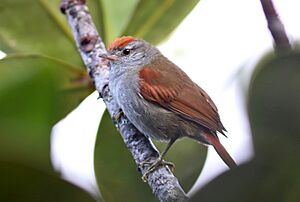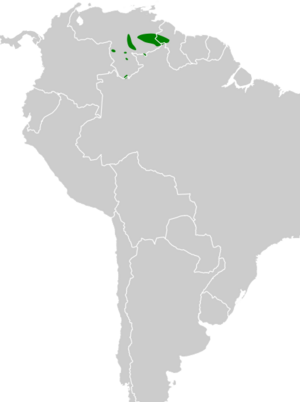Tepui spinetail facts for kids
Quick facts for kids Tepui spinetail |
|
|---|---|
 |
|
| Conservation status | |
| Scientific classification | |
| Genus: |
Cranioleuca
|
| Species: |
demissa
|
 |
|
The tepui spinetail (Cranioleuca demissa) is a small bird that belongs to the ovenbird family, called Furnariidae. You can find this unique bird in parts of Brazil, Guyana, and Venezuela. It gets its name from the "tepuis," which are flat-topped mountains where it lives.
Contents
What is a Tepui Spinetail?
The tepui spinetail is a small bird, about 14 to 15 centimeters (5.5 to 5.9 inches) long. It weighs around 14 to 17 grams (0.5 to 0.6 ounces), which is about as much as a few coins! Both male and female tepui spinetails look very similar.
They have a reddish-chestnut crown on their head and a rich brown back. Their wings are also reddish-chestnut. Their tail is a dark reddish-chestnut and looks a bit spiny at the ends because some feathers don't have full barbs. Their face is a dull brownish color with some pale streaks, and they have a whitish stripe above their eye. Their throat is whitish, and the rest of their belly is gray.
The tepui spinetail has chestnut-colored eyes. Its upper beak is dark brown to black, and its lower beak is pinkish with a dark tip. Its legs and feet are olive-yellow to olive-brown. Young tepui spinetails look a bit different, with a brown crown and more olive-colored backs and bellies.
Where Does the Tepui Spinetail Live?
The tepui spinetail lives in the tepui mountains, which are found where southeastern Venezuela, west-central Guyana, and northern Brazil meet. Another group of these birds lives on tepuis in southern Venezuela.
These birds prefer to live in mountain evergreen forests and woodlands. They usually live at high elevations, between 1,100 and 2,450 meters (3,600 and 8,000 feet) above sea level. They can also be found in special "gallery forests" in the Gran Sabana area of Venezuela.
How Does the Tepui Spinetail Behave?
The tepui spinetail stays in its home region all year long. It does not migrate to other places.
What Does the Tepui Spinetail Eat?
The tepui spinetail mainly eats arthropods, which are creatures like insects and spiders. It usually looks for food alone or with a partner. Often, it joins a group of different bird species that are all foraging together.
This bird searches for food from the middle parts of the forest up to the very top of the trees. It is very agile and can climb along small branches. It picks its prey from tree bark and other debris.
Reproduction and Nesting
We don't know much about how the tepui spinetail raises its young. We do know that its nest is shaped like a globe and is made of moss. It hangs from a tree branch.
What Sounds Does It Make?
The song of the tepui spinetail is a thin, fast series of notes that go down in pitch. It sounds like "téé-téé-te-ti ti'ti'ti'ti'ti'i'i'i'." When it senses danger, its alarm call is a high, short, dry rattling sound.
Is the Tepui Spinetail in Danger?
The IUCN (International Union for Conservation of Nature) has looked at the tepui spinetail and says it is a species of "Least Concern." This means it is not currently considered to be in danger of extinction. We don't know exactly how many of these birds there are, but their numbers seem to be stable. There are no immediate threats that scientists have found. The bird is thought to be quite common within the limited area where it lives.


